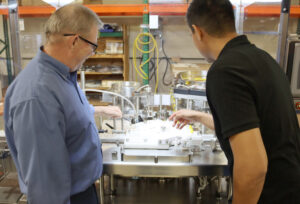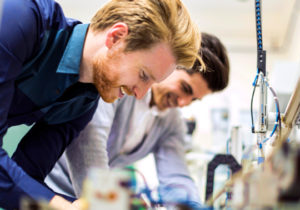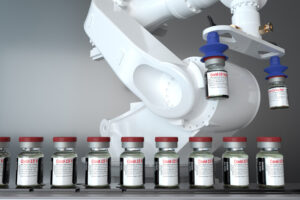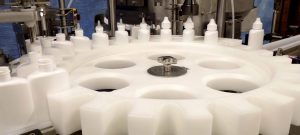
As we know in today’s world of packaging, automation is playing an essential role across a wide variety of industries – diagnostic, medical, cosmetic, personal care, food/beverage, and pharmaceuticals. More specifically, the liquid packaging industry is experiencing exponential growth and continuing to evolve as a dynamic sector full of innovative and technologically advanced equipment. And as industries are constantly looking to streamline their operational practices, businesses are incorporating more and more these automated solutions.
For starters and where possible, these businesses are looking to substitute higher levels of automation for different areas of human touchpoints. This increase in automation can also help in a number of other ways including increased productivity, manufacturing consistency, reduced downtime, as well as higher levels of production and scheduling flexibility.
Today, we’re going to be reviewing ‘MarketTRENDS: How Automation is Changing Packaging Options – Part #1’ through an extensive conversation with Aaron Saxton, Director of Sales/Marketing, FILAMATIC. We will discuss how different customers, their applications, compliance requirements, and the incorporation of automated equipment are impacting the liquid filling industry. Through a standard Q&A format and with in-depth insight and a considerable packaging equipment background, Aaron will share what an automated system truly involves as well as how he sees trends in packaging, i.e. automation, continuing to evolve over the next few years.
Question#1: What is an automated filling system?
Answer: Aaron confirms, “understanding the basics here is important… an automated filling system is something that fundamentally removes as many manual operations as possible from the process. It’s designed to process a commodity or product more effectively or smoothly into its primary packaging. Whether the system is a fill only, fill-cap with fill stopper, or cap with a fill-tip-cap requirement, there are multiple processes that exist within the filling and closing arena. Automated systems can perform as few or as many steps needed to reduce the number of interventions or individual steps within a production process.”
Question#2: Is there a specific reason to use or need a fully automated filling system?
Answer: “Yes. Given the many different industries coupled by the mountain of different applications, there can be a variety of reasons why an automated packaging system makes sense for your project. For instance, if you’re filling a product that is expensive, precious or needs a high level of accuracy, automation is probably one of the better ways to approach this type of application. An automated system can help ensure your product is being filled, processed, and packaged within an ISO 5 environment that has no foreign material.”
He also notes, “other examples that can drive automation include hazardous or dangerous products, such as radioactive elements, products with an explosive element, or any other products that cannot come into contact with people. Here, choosing a level of automation is usually a function of line speed requirements, the manufacturing environment, or sterility requirements.”
“It may also be driven by labor reallocation …
also for product quality, speed of the product,
reduction of overhead, as well as process simplification.”
“It may also be driven by labor reallocation when it’s more practical to have one or two people running an assembly line instead of twenty people on the same assembly line. And as we briefly discussed, some other reasons why companies choose to automate are also for product quality, speed of the product, reduction of overhead, and process simplification.”
And from our own research, we know even more reasons companies choose automation is to combine multiple processes into one piece of equipment. We learned through filling a product on a line that includes both a checkweigher that ensures it meets the weight requirement and a separate labeler, these processes can be consolidated into one automated piece of equipment. This shrinks up the floor space by using one piece of equipment that does it all instead of having two or three separate elements in the process.
Question#3: Are there industries more applicable to using these types of automated filling systems?
Answer: “Yes. All industries use some form of packaging equipment and then some level of automation within that packaging process. However, there are certain industries that tend to require or lean towards automation a bit more than the rest. Anything in the medical arena over a certain batch size typically incorporates automation. Industries such as pharmaceutical, diagnostic, and biotech, life sciences, are moving towards increased levels of manufacturing and packaging automation. Those manufacturers in the field of life sciences are on a mission to take the next step to reducing labor in their production processes.”
Aaron emphasizes, “in some cases, these are lifesaving and incredibly important medicines, and the least sterile parts of the process are the manual steps involved in filling the container. Companies in these areas seek more automation than some other industries.”
As we know, pharmaceutical, diagnostic, biotech, and certain areas of food and beverage already implement a high level of automation because of the sheer volume of product manufactured. Cosmetic and personal care products are manufactured with high levels of automation as well, generally speaking. However, whether some of these other industries will mass incorporate higher levels of automated manufacturing still remains to be seen. But we do believe the increased flexibility while optimizing the amount of labor needed to run production is pushing these spaces in working towards how to incorporate more rather less automation.
Question#4: There is a wide range of industries using these types of automated filling systems, what is the difference between a system in the pharmaceutical versus the food and beverage industry?
Answer: “Typically, the bulk of the packaging industry is centered around the food and beverage market where products are usually run at high speeds and the margin on a container, such as orange juice, is slim. To maximize production or maximize revenue potential, it’s necessary for these companies to produce as quickly as possible in the most cost-effective manner.”
Aaron continues with, “systems in food and beverage run at 100, 200, 500, and even up to 1,000 containers a minute to produce at the lowest possible cost. Compare this to the diagnostics market – high speeds are not as common rather other performance characteristics are more critical, such as accuracy, quality, and repeatable fills. Filling a vaccine dose for a diagnostic or pharmaceutical company versus a 64oz of orange juice in a bottle has different implications when reviewing quality, accuracy, and repeatable fill volumes. It is imperative to dispense the exact amount into the container, so simply put – the process is different …
“All manufacturers care about the same things but have different criteria for success.”
… this means it’s a question of how to balance when to get an accurate fill for an item such as a pharmaceutical product and when to utilize a high-speed line and weighing options. Simply having a high-speed line doesn’t mean you automatically forgo quality and accuracy, but the question may be how to get an accurate fill vs speed – many times different types of assets get different types of machines to fit different market segments, which may require different machines to fit different applications.”
Question#5: Can an automated filling system handle or fill any type of container or fill volume?
Answer: Aaron answers, “the short answer is no. However, the word ‘any’ makes this a broad question. What is most important, which we, FILAMATIC, do very well, is building in flexibility into your filling system without sacrificing quality and control. Obviously, packaging has evolved over time, but customers who acquired our equipment over 35 years ago are still producing new products on some of those same systems. We’d be happy to sell them a new one, but it is a testament to the longevity and overall quality of our FILAMATIC filling systems.
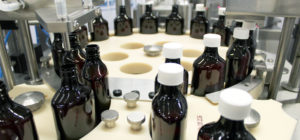
And of course, flexibility is important, but no one machine does everything well. We design and engineer a great deal of flexibility and quality into every solution – helping them stand the test of time. The use of servos, robots, cobots, and other different elements makes each system more flexible than they were in the past.
Question#6: How does an automated filling system handle unstable or sensitive containers?
Answer: He confidently states, “this depends upon the commodity, for example, FILAMATIC has equipment that supports micro-vials, small, unstable containers, as well as solutions that help with tall, cylindrical containers that fall over easily. What it boils down to is the wholistic or conceptual approach to the project/project solution. This methodology has been very successful for our customers, where we take a very modular approach to the machine and elements of each area of need. This all occurs within the preplanning stages – a collaborative approach that we engage in with each partner for each project.”
He continues, “our systems have the capability to handle a wide variety of these challenging containers; this high level of flexibility underscored with unique quality is woven throughout the DNA of every FILAMATIC system. Some companies deal with unstable elements by directly inserting them into the automated system, done, versus taking the time and working in a collaborative sense in finding the best options to successfully send your container down the conveyor line. At times, the former process can be slightly faster; however, without appropriate study and thorough analysis, it will assuredly be a gamble with your final solution which could then provide constant headaches as a manufacturing approach.”
FILAMATIC designs a variety of systems for multiple entry points in terms of your containers, such as feeding a round, square, or an unstable container and once it gets into the system, all the other modules work together accordingly to successfully move it down the line. Depending upon the range of your containers, there may be a combination of methods or mechanisms used to deliver containers into your system.
Aaron highlights a specific example, “a manufacturer producing test kits for COVID uses a long, very narrow, cylindrical tube, which fell when fed on a standard conveyor. We used a specialized vibratory bowl that was placed directly into the Monobloc system, automated filling solution, and fed the commodity directly into the turret system. Sometimes unscrambling systems are also integrated into these areas but its certainly a case by case basis give the application at hand.
Customers that manufacture blood products have similar issues because the glass containers typically do not have a rim to feed them, adding an unscrambling bowl solves these challenges. Vibratory systems can be used at the end of the process. If a cylindrical commodity needs to transfer to the next step, sometimes a rail is used to feed it downstream. When the commodity doesn’t have a neck ring to support it, transfer can be accomplished with a rotate, pick, and place system to get the packaging on a different plane for further processing.
And even other situations call for cobots or robots to feed into an automated system. If a customer does not want a vibratory bowl to infeed the closures, one option is to utilize an automated robot/cobot type system. This is used to bypass the bowl and retrieval with cobots is used as the pick-and-place mechanism for closures on the containers. There are many ways to solve these challenges, it just requires a creative, collaborative approach with the right partner to get unstable commodities successfully through various points in the manufacturing process.”
Closing – Part #1
As we close, ‘MarketTRENDS: How Automation is Changing Packaging Options – Part #1‘, we learned a great deal through our conversation with Aaron Saxton, Director of Sales/Marketing, FILAMATIC.
- What is automation or an automated filling system?
- Is there a specific reason to use a fully automated filling system?
- Are there industries more prone to using these types of automated filling solutions?
- What are the different requirements from a Pharmaceutical vs Food/Beverage type automated system?
- Can an automated filling system handle any type of container or fill volume?
- How does an automated filling system handle unstable or challenging, sensitive containers?
Great discussion. Please stay tuned for our follow-up conversation with Aaron Saxton in a continued ‘MarketTRENDS: How Automation is Changing Packaging Options – Part #2‘. We look forward to discussing more areas of how automation is influencing our different customers, their projects, and how we work together in designing the best solutions for their projects.
Specialists in Liquid Filling Systems
For more information on our semi-automatic tabletop filling machines, turnkey automatic fill-cap-label systems, or fully automated, integrated filling solutions, please call 866.258.1914 or email info@filamatic.com.
Unique performance. Undeniable quality. Unrivaled support.
Go further and do more with FILAMATIC – Specialists in Liquid Filling Systems.

